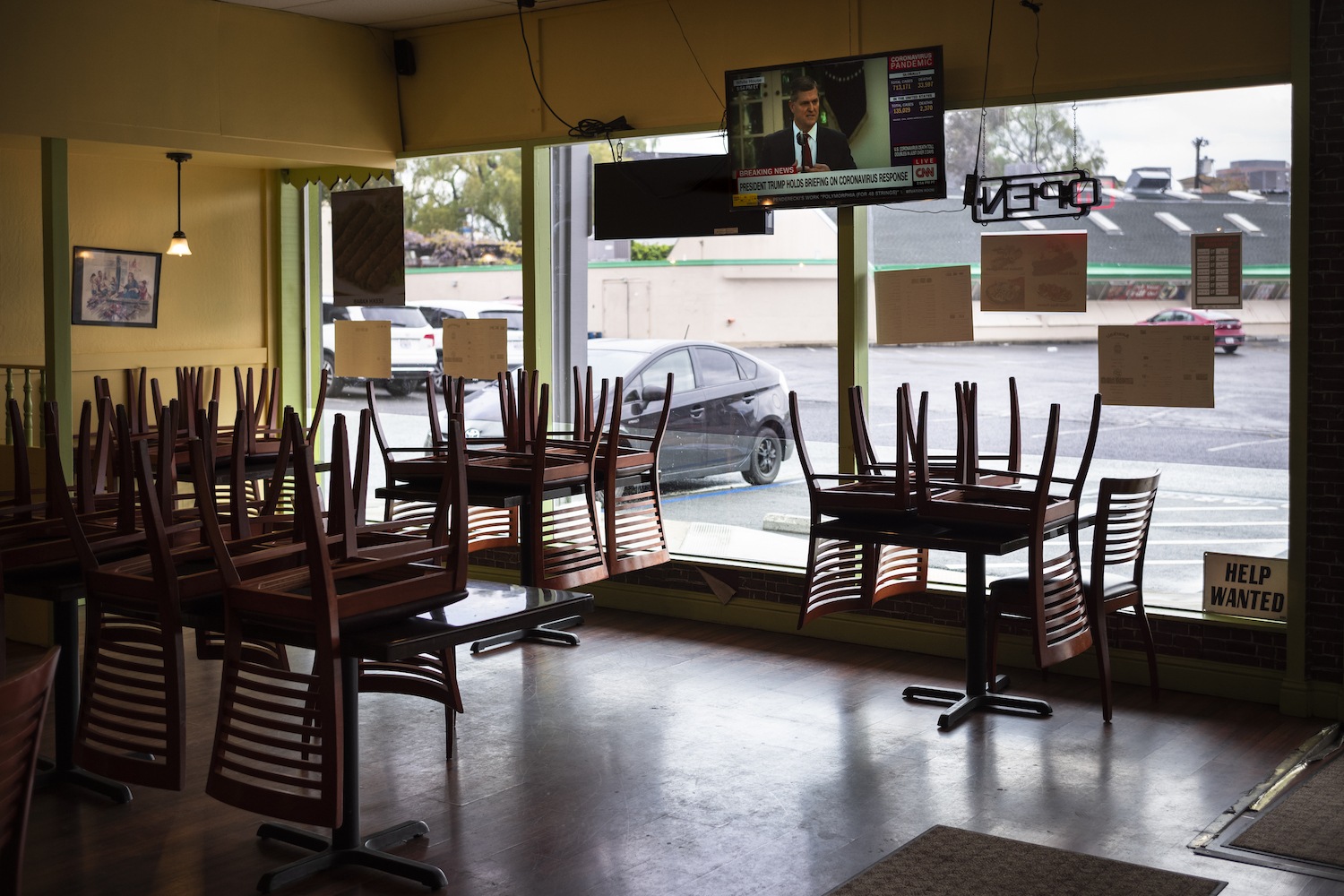
Union Square Hospitality Group
Reduced-capacity indoor dining alone isn’t enough to keep a restaurant afloat. So restaurateurs are scrambling to figure out how, and whether, to extend their outdoor dining operations, even as the clock ticks and winter gets closer.
At six in the evening, most of the 25 outdoor tables are full at Bavel, one of Los Angeles’s most popular restaurants. Its three patios re-opened in July and have done steady business since, serving about 160 guests nightly in a city where winter means a rare rain shower and manageable average temperatures in the 50s.
And yet Genevieve Gergis, co-owner and pastry chef at Bavel and its sister restaurant, Bestia, makes a grim prediction: “I do not foresee us being open for the winter,” she said. “It’s just not going to happen.” Los Angeles is one of the few major cities that still prohibits indoor dining, and Bavel’s healthy outdoor business isn’t enough on its own. Even if it were, there’s no guarantee diners will keep coming as the weather dips.
Restaurateurs are scrambling to figure out how, and whether, to extend their outdoor dining operations, even as the clock ticks and winter gets closer. Investing in weather protection takes time, a better understanding of changing health and building codes, and, most of all, a reliable sense of what the pandemic will look like and if diners will venture out in the coming months—which nobody has.

Los Angeles’ Bavel serves about 160 guests nightly on their patios, as compared to their usual 450 per night. Without indoor dining, co-owner and pastry chef Genevieve Gergis does not foresee Bavel being open through the winter.
Bavel
A frightening truth has emerged: All but one of the restaurateurs who spoke to The Counter for this story predicted that they may have to close their doors, no matter what kind of canopies or space heaters or lap rugs they employ, no matter if they already offer reduced-capacity indoor seating. Nearly 100,000 restaurants nationwide have already closed due to Covid-19, according to the National Restaurant Association, and more closures are projected, with the industry on track to lose $240 billion this year—a different kind of second wave, devastating in its own way.
Danny Meyer, founder and CEO of Union Square Hospitality Group, is confident that his restaurants will survive the winter, now that New York City has announced that indoor dining at 25 percent capacity will begin on September 30. Meyer’s Gramercy Tavern, in the city’s Flatiron district, constructed a 60-seat patio space outside the 190-seat restaurant—but a recent rainstorm in the middle of dinner service forced diners to cut their meals short. “If we had 25 percent indoor capacity,” said Meyer, “we could have safely moved everyone indoors.” Though diner behavior is the big unknown here, Meyer has one other profound advantage: He owns the Gramercy Tavern space, so rent isn’t an issue.
Meyer plans to keep Gramercy Tavern’s patio open at least through October 31, when New York City’s temporary outdoor permits are set to expire. Though he will not invest more in the outdoor space, he thinks the city should extend outdoor dining indefinitely to give restaurants, especially smaller ones with limited indoor space, more opportunity for revenue. “Consumers will determine whether they want to do it,” he said of outdoor dining, though, “New Yorkers will not freeze their way through dinner.”
“I don’t know if it would make sense to continue if we were at normal capacity. And I don’t know how popular it will be once it’s 45 degrees and drizzling.”
Alex Raij, who co-owns four Spanish restaurants in Manhattan and Brooklyn with her husband, Eder Montero, decided not to invest in outdoor improvements at La Vara, the only one of her restaurants that’s open for outdoor dining, because the October 31 deadline is so soon. But limited indoor dining won’t save her restaurants, either, because they are small. The 35-seat La Vara would be allowed two indoor tables at 25 percent capacity, so she intends to expand her 10-table outdoor service for as long as possible, adding more evening hours and brunch service. When it gets too cold, she’ll rely on a new take-out menu and private parties to keep her afloat.
In cities that already permit reduced indoor dining, restaurateurs are likely to take a chance on a seasonal outdoor buildout; they’ve already seen firsthand that neither income stream is sufficient on its own, and made an initial investment in an outdoor space, so they hope to extend its life.
[Subscribe to our 2x-weekly newsletter and never miss a story.]
Chef Mitch Mayers, owner of Seattle’s Sawyer, a James Beard Award semi-finalist for Best New Restaurant in 2019, can’t afford to lose an existing patio and new terrace, which generate 35 percent of his current business. He also can’t afford the quotes he just got for weather-proofing the terrace: $15,000 to install an awning and $2,000 for heaters. He’s looking into less expensive options and weighing how much to invest when there’s no guarantee his 4,700-square-foot indoor space will be allowed to operate above 50 percent capacity, or that diners will eat outside in winter. “I don’t know if it would make sense to continue if we were at normal capacity,” he said, of the new terrace. “And I don’t know how popular it will be once it’s 45 degrees and drizzling.”

Seattle’s Sawyer can’t afford to lose an existing patio and new terrace, which currently generate 35 percent of their business.
Sawyer
In Athens, Georgia, chef Hugh Acheson intends to embrace the inevitable by creating a winter-themed outdoor space. His flagship restaurant, Five & Ten, has a big, covered wraparound porch and patio that seat 36 and represent 50 to 60 percent of the restaurant’s current revenues. Acheson is making some obvious changes, with heaters and earlier hours, but he’s also considering a ski resort-inspired menu and blankets to make his guests feel comfortable eating outside in winter. He’s prepared to invest up to $10,000, even though any outlay right now is a calculated risk.
“I’m banking on a hope that people will eat outside in 45-degree temperatures,” he said. “But who knows?” With the restaurant doing quite well, in pandemic terms—75 to 80 percent of its normal revenues, thanks to that porch—he feels he has to take the chance.
And while winter in Southern California may seem like a joke to anyone who owns a thermal jacket, everything is relative: Los Angeles gets enough rain, wind and cooler temperatures to make outdoor dining unpleasant. Gergis and Leah Bunch, Bavel’s director of operations, are convinced that one week of rain will sink Bavel.

In Athens, Georgia, Five & Ten boasts a big, covered wraparound porch and patio that seats 36, and currently represents 50-60 percent of the restaurant’s revenues
Five & Ten
“People don’t want to eat their dinner in a puddle,” said Bunch. Heaters could provide some comfort, but they’re expensive and won’t protect against rain. Tents would help, especially on Bavel’s two uncovered patios, but they are prohibited under current regulations. So Gergis and her husband, chef Ori Menashe, are holding off on making further investments as long as possible, in the hope that the city approves indoor dining or eases restrictions.
There isn’t much time, because a restaurant of Bavel’s size can go bankrupt in a matter of weeks. “Just to close down temporarily, with no one taking a penny, will cost $60,000 a month,” said Gergis, between outstanding loans, insurance, utilities, and rent. The longer a restaurant remains closed, the more debt it will incur, eventually forcing the restaurant to close for good.
Until there’s some news on local and national next steps, restaurateurs are stuck with weather roulette: wait as long as possible to spend more money outdoors, and, when the weather turns, hope they can shift to climate-proof options like indoor dining, takeout and delivery, meal kits and pantry operations. Some said that assistance—such as grants for heaters and umbrellas, city-approved designs for outdoor structures, funding through the Restaurants Act, and programs paying restaurants to prepare meals for their communities—would help them stay afloat.
“People don’t want to eat their dinner in a puddle.”
Some cities move faster than others. The Los Angeles mayor’s office extended its temporary outdoor dining permits through the end of 2020, and is debating whether to adapt the program beyond that timeframe. The Seattle Department of Transportation plans to issue guidelines on canopies and umbrellas this month, in response to restaurant inquiries about rain protection for the winter. Both cities say they are open to feedback from restaurant communities on how best to facilitiate winter outdoor dining.
The fate of outdoor dining in New York City and Athens is unclear. New York City officials did not respond to several requests for comment on whether outdoor dining permits will be extended beyond October 31, though they have said the program will return in June. And Athens Central Services Department said its parklet program, which allows restaurants to expand outdoor dining into public parking, could be extended beyond the November 12 deadline, though the program hasn’t been as popular as expected.
An impatient Gergis wishes that local and federal officials better understood just how dire this next stage promises to be, as debt becomes “insurmountable” and temporary closures become permanent.
“The worst,” she said, “has not happened yet.”





